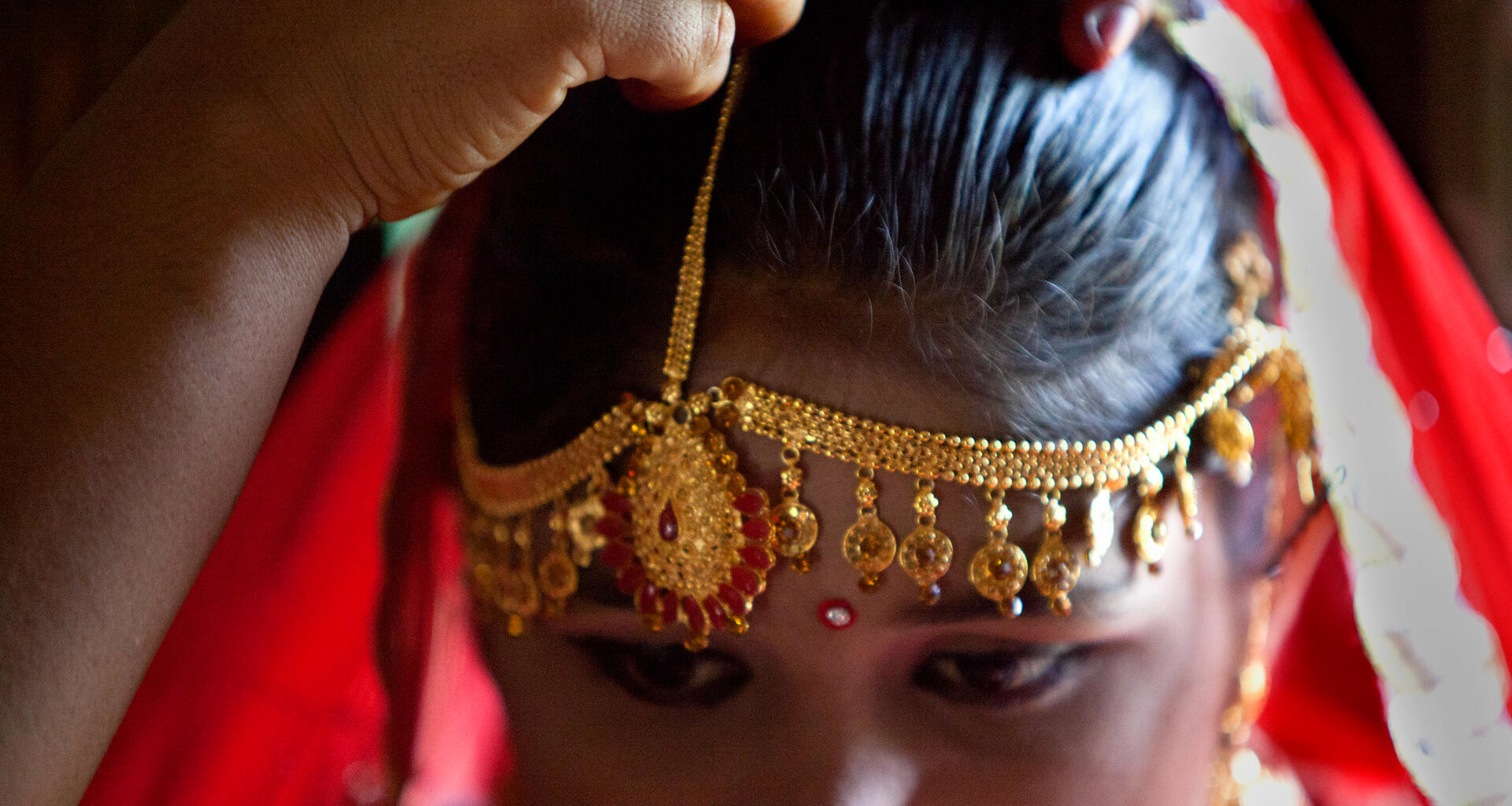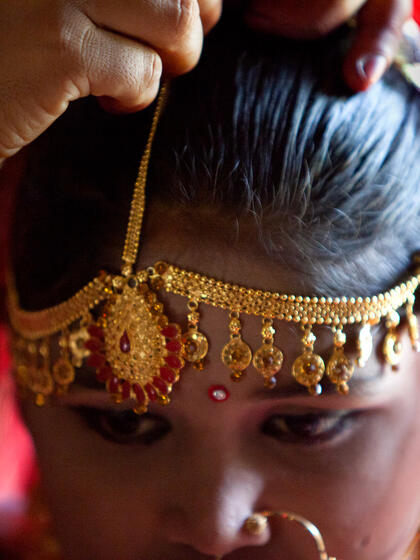Child marriage is a human rights violation. It refers to any formal marriage or informal union of a child under the age of 18 with an adult or with another child. Despite laws against it, the practice remains widespread.
Globally, one in every five girls is formally married or in an informal union before reaching age 18. An estimated 640 million girls and women alive today were married in childhood; each year 12 million adolescent girls are married before the age of 18; every three seconds an adolescent girl gets married somewhere in the world.
Child marriage threatens girls’ lives and health, and it limits their future prospects. Girls pressed into child marriage often become pregnant while still adolescents, increasing the risk of complications in pregnancy or childbirth – the leading cause of death among older adolescent girls. They are also more likely to experience physical or sexual intimate partner violence.
UNFPA promotes policies, programmes and legislation designed to end child marriage. UNFPA supports evidence-based, rights-based, girl-centred investments that empower adolescent girls with the information, skills and services they need to be healthy, educated and safe, which helps them make a successful transition to adulthood. UNFPA also works to support the needs of married adolescent girls, particularly in family planning and maternal health.
Child marriage denies girls the right to choose whom and when to marry – one of life’s most important decisions. Choosing one’s partner is a major decision, one that should be made freely and without fear or coercion.
Many international agreements outlaw child marriage, including the Convention on the Rights of the Child and the Convention on the Elimination of all Forms of Discrimination against Women. The Programme of Action of the International Conference on Population and Development in 1994 also called on countries to eliminate child marriage.
Despite near-universal commitments to end child marriage, 19 per cent of girls are married before age 18, which means thousands of girls every single day. Four per cent of girls are married before age 15. Girls who are married or enter informal unions early are denied the right to equality, education and a standard of living adequate for their health and well-being and that of their family.
Child marriage is both a symptom and a result of deep-seated gender inequalities and restrictive gender norms and stereotypes. Child marriage impacts mostly adolescent girls from the poorest households and rural areas and with less access to education, reflecting a broader societal imbalance where girls are often seen as property or inferior to boys and men.
Child marriage is a serious barrier to achieving gender equality worldwide. It deprives adolescent girls of the enjoyment of their human rights; neglects their bodily autonomy; deprives them of autonomy and economic well-being; and puts them at risk of adolescent pregnancy and gender-based violence.
All 193 United Nations Member States have agreed to end child marriage by 2030 under the Sustainable Development Goals. Target 5.3 of the goals is aimed at eliminating harmful practices such as child, early and forced marriage and female genital mutilation by 2030.
Addressing child marriage necessitates gender-transformative approaches, including tackling harmful gender roles, social norms, gender stereotypes and power relations.
Child marriage directly threatens girls’ health and well-being. Marriage is often followed by pregnancy, even if a girl is not yet physically or mentally ready. In developing countries, a majority of births to adolescent girls occur within a marriage or a union. In these countries, complications from pregnancy and childbirth are a leading cause of death among adolescent girls aged 15 to 19.
Girls married as children are more likely to be exposed to sexually transmitted infections, including HIV, and physical and sexual intimate partner violence. When girls marry, they are often forced to drop out of school so they can assume household responsibilities. Girls who leave school have worse health and economic outcomes than those who stay in school. These disadvantages often extend to their children, perpetuating a cycle of poverty and gender inequality.
Child marriage is the toxic product of economic inequality and gender inequality. Girls in child marriages tend to be less educated, and they are more likely to live in rural areas. Many impoverished parents believe that marriage will secure their daughters’ future by ensuring that another family will be responsible for their care. This is also true in humanitarian crises, when many parents fear they will be unable to protect or care for their daughters. Some mistakenly believe marriage will protect their daughters from pregnancy out of wedlock and sexual violence, which is often exacerbated in times of crisis.
Some parents see their daughters as burdens or commodities, a perception exacerbated in times of crisis. In places where the bride’s family pays a dowry to the groom’s family, younger brides typically command smaller dowries, creating an incentive for parents to marry their daughters off early. In places where the groom’s family pays a bride price, parents in difficult circumstances may marry off their daughters as a source of income.
Child marriage often stems from limited opportunities, a consequence of gender inequality and a lack of girls’ rights. When girls have genuine agency and empowerment, they are far more likely to delay marriage.
Global child marriage rates are slowly falling. Recent data show that 68 million child marriages were averted in the last 25 years. Around 2000, one in three women between the ages of 20 and 24 reported they had been married as children. In 2021, this number dropped to around one in five.
Still, progress has been uneven, and child marriage is not declining fast enough. Because of population growth in regions where child marriage is more prevalent, as well as the socioeconomic impacts of COVID-19, the total number of child marriages is projected to increase by 2030. To change this, we must accelerate our actions to end child marriage.
Ending child marriage could be surprisingly affordable. In 2019, UNFPA released a joint study with Johns Hopkins University, in collaboration with Victoria University, the University of Washington and Avenir Health, assessing the price tag to end child marriage in 68 countries that account for about 90 per cent of these marriages. Ending child marriage in these countries by 2030, researchers concluded, would cost just $35 billion – roughly $600 to spare each child bride.
Laws against child marriage must also be enforced, especially when girls at risk of child marriage, or who are already married, seek protection and justice. And where it is not yet the case, the legal age of marriage should be raised to 18 without exceptions. However, laws only provide the framework for action against child marriage. Practices people deem acceptable are unlikely to disappear through legislation alone. Addressing the deep-rooted gender social norms that condone child marriage requires broader societal shifts to truly eradicate the practice.
Governments, civil society and other partners must work together to ensure that girls have access to quality education, economic opportunities and livelihoods, health information and services, comprehensive sexuality education and life-skills training. Girls who are able to stay in school and remain healthy enjoy a broader range of options, and they are more likely to be able to avoid child marriage.
And, importantly, girls who are already married or in a union need to be supported. They need sexual and reproductive health services to help them avoid early pregnancy and sexually transmitted infections including HIV. Those who become pregnant need access to appropriate care throughout pregnancy, childbirth and in the post-partum period. They should be supported, if they choose, in returning to formal or non-formal education, and be protected against other forms of violence and coercion
Together, these measures lead to more bodily autonomy for girls, to their being more in control of their lives, to healthier families, to higher levels of gender equality and, in turn, to stronger societies and more vibrant economies. No society can afford the lost opportunity, waste of talent or personal devastation that child marriage causes.
UNFPA is committed to delivering tangible, evidence-based solutions to child marriage with an emphasis on efforts that are gender-transformative, can be scaled up, can be sustained and can produce measurable results. UNFPA works with governments and civil society partners at all levels to promote and protect the human rights of adolescent girls – including assisting with the development of sexual and reproductive health, gender and youth policies, programmes and services – and to transform stereotypes and gender norms to end the practice of child marriage.
UNFPA works in more than 66 countries promoting adolescent girl-centred programmes to equip them with social, health and economic assets and skills to transition healthily and safely into adulthood. These programmes empower them to navigate challenges, make informed decisions and actively participate in their communities as independent young women.
The UNFPA-UNICEF Global Programme to End Child Marriage is the UN flagship multicountry initiative that demonstrates the power of global partnerships and targeted interventions to scale up adolescent responsive services, engage governments and communities, transform harmful gender norms and stereotypes, and empower adolescent girls to know and exercise their human rights, including their right to choose, as adults, whether, when and whom to marry.
Updated 13 February 2025

Every day, tens of thousands of girls are forced to be child brides globally.
This is a violation of human rights.
StandUp4HumanRights today and join @UNFPA to take action: unf.pa/chu
#EndChildMarriage



